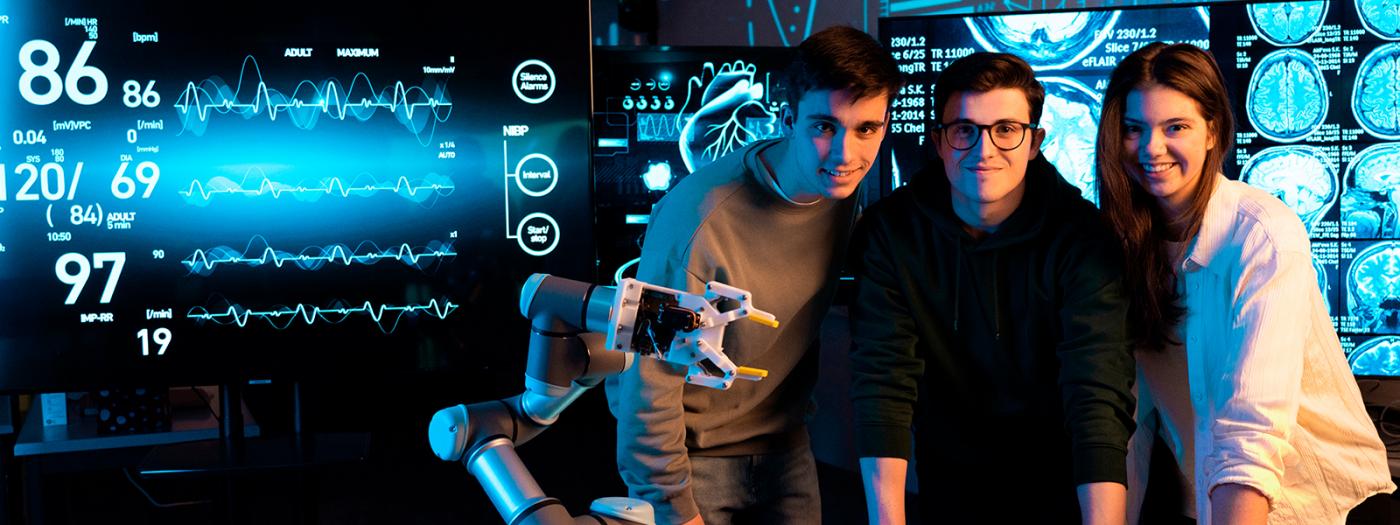The main goal of this course is to transfer concepts of assistive robotics. Assistive robotics is the area within robotics devoted to assisting or supporting people in their daily lives. Application examples of such systems range from promoting the development of motor or cognitive abilities, anxiety reduction or providing companionship to helping end-users performing repetitive tasks. Given that this type of robotics is devoted to people, the social aspect has a crucial role, and as consequence, robots must be capable of replying to human beings in a similar way.
In this course, we will start reviewing basic concepts of robotics in general to familiarize the students with the terminology. We will next introduce concepts of assistive robotics: What is it? What characterizes assistive robotics? Where can we apply it? Finally, and as the main section of the course, we will review international academic works related to assistive robotics to analyze in depth the ideas and usefulness of the field.
At the end of the course, the students should be capable of identifying those situations where assistive robotics can become part of a solution, as well as designing the main functionalities and features the robotic system should cover to respond to some of the end-users' needs.
Titular Professors
Professors
Introduction to robotics, programming, Linux, ROS, python
Learning outcomes of this subject are:
RA.1 Fundamental knowledge of robotics terminology.
RA.2 Fundamental knowledge of research methods.
RA.3 Characterization of assistive robotics.
RA.4 Identification of essential social aspects involved in human-robot interaction settings.
RA.5 Review of assistive robotics applications.
RA.6 Review of state-of-the-art assistive robotic systems, analysis of their main features, and discussion on their contributions.
RA.7 Design, implementation, and evaluation of an assistive robotic system.
PART I. Concept review
1. Fundamentals of robotics
1.1. What is a robot?
1.2. Main components
1.3. Locomotion
1.4. Manipulation
1.5. Sensors
1.6. Control architectures
2. Research methods
2.1. Qualitative vs Quantitative methods
2.2. Qualitative methods
2.2.1. Ethnography or participant observation
2.2.2 Focus groups
2.2.3. In-depth interview
2.3. Quantitative methods
2.3.1. Case studies
2.3.2 Field studies
2.3.3. Surveys
2.3.4. Experiments
PART II. Assistive robotics
1. Introduction to assistive robotics
1.1. What is assistive robotics?
1.2. Interaction and adaptation
1.3. Brief history
2. Human-Robot Interaction
2.1. What is it?
2.2. Design
2.3. Spatial Interaction
2.4. Nonverbal communication
2.4.1. Paraverbal communication
2.4.2 Body expression
2.4.3. Facial expression
2.5. Verbal communication
2.6. Emotion
2.7. Alternative communication means
2.7.1. Tactile and haptic
2.7.2. Screens and GUIs
2.7.3. Physiological information
3. Assistive robotics application areas
3.1. Health
3.2. Home
3.3. Education
3.4. Service
3.5. Industry
3.6. Office
3.7. Companionship/entertainment
PART III. Assistive robotics research review
(Scientific paper review to be determined throughout the current academic year to cover sections 2 and 3 from Part II)
The course applies the following methodologies:
Part I and Part II: lecture sessions. Use of slides and videos.
Part III: research paper reading and analysis (out of class) and discussion (in-person in class).
Practice: we will work in small groups with one of our state-of-the-art robots in the lab: the UR3 industrial robot (Universal Robots, robotic arm) and/or the Nao robot (Softbank Robotics, humanoid). The practice covers the design and development of an assistive robot application.
PAPERS
The course is evaluated through continuous evaluation on the paper analysis carried out throughout the course.
PRACTICE
Development of a robotic assistive application
The evaluation of the course is composed of two aspects: papers and practice.
PAPERS
Paper score = 60% written analysis + 40% class contribution
PRACTICE
Practice score = 40% functional + 40% interaction + 20% development
FINAL
It is mandatory to approve the individual parts to compute the final mark.
Final score = 50% papers score + 50% practice score
[1] Mataric, M. (2007) The Robotics Primer, The MIT press.
[2] Feil-Seifer, David & J Matari?, Maja. (2005). Defining Socially Assistive Robotics. Proceedings of the IEEE 9th International Conference on Rehabilitation Robotics. pp 465 - 468. 10.1109/ICORR.2005.1501143.
[3] Christoph Bartneck, Tony Belpaeme, Friederike Eyssel, Takayuki Kanda, Merel Keijsers and Selma Sabanovi? Human- Robot Interaction. An Introduction (2019). Cambridge University Press (https://www.human-robot-interaction.org)
